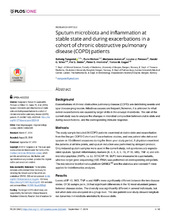| dc.description.abstract | Background: Exacerbations of chronic obstructive pulmonary disease (COPD) are debilitating events and spur disease progression. Infectious causes are frequent; however, it is unknown to what extent exacerbations are caused by larger shifts in the airways’ microbiota. The aim of the current study was to analyse the changes in microbial composition between stable state and during exacerbations, and the corresponding immune response. Methods: The study sample included 36 COPD patients examined at stable state and exacerbation from the Bergen COPD Cohort and Exacerbations studies, and one patient who delivered sputum on 13 different occasions during the three-year study period. A physician examined the patients at all time points, and sputum induction was performed by stringent protocol. Only induced sputum samples were used in the current study, not spontaneously expectorated sputum. Sputum inflammatory markers (IL-6, IL-8, IL-18, IP-10, MIG, TNF-α) and antimicrobial peptides (AMPs, i.e. LL-37/hCAP-18, SLPI) were measured in supernatants, whereas target gene sequencing (16S rRNA) was performed on corresponding cell pellets. The microbiome bioinformatics platform QIIME2TM and the statistics environment R were applied for bioinformatics analyses. Results: Levels of IP-10, MIG, TNF-α and AMPs were significantly different between the two disease states. Of 36 sample pairs, 24 had significant differences in the 12 most abundant genera between disease states. The diversity was significantly different in several individuals, but not when data was analysed on a group level. The one patient case study showed longitudinal dynamics in microbiota unrelated to disease state. Conclusion: Changes in the sputum microbiota with changing COPD disease states are common, and are accompanied by changes in inflammatory markers. However, the changes are highly individual and heterogeneous events. | en_US |

